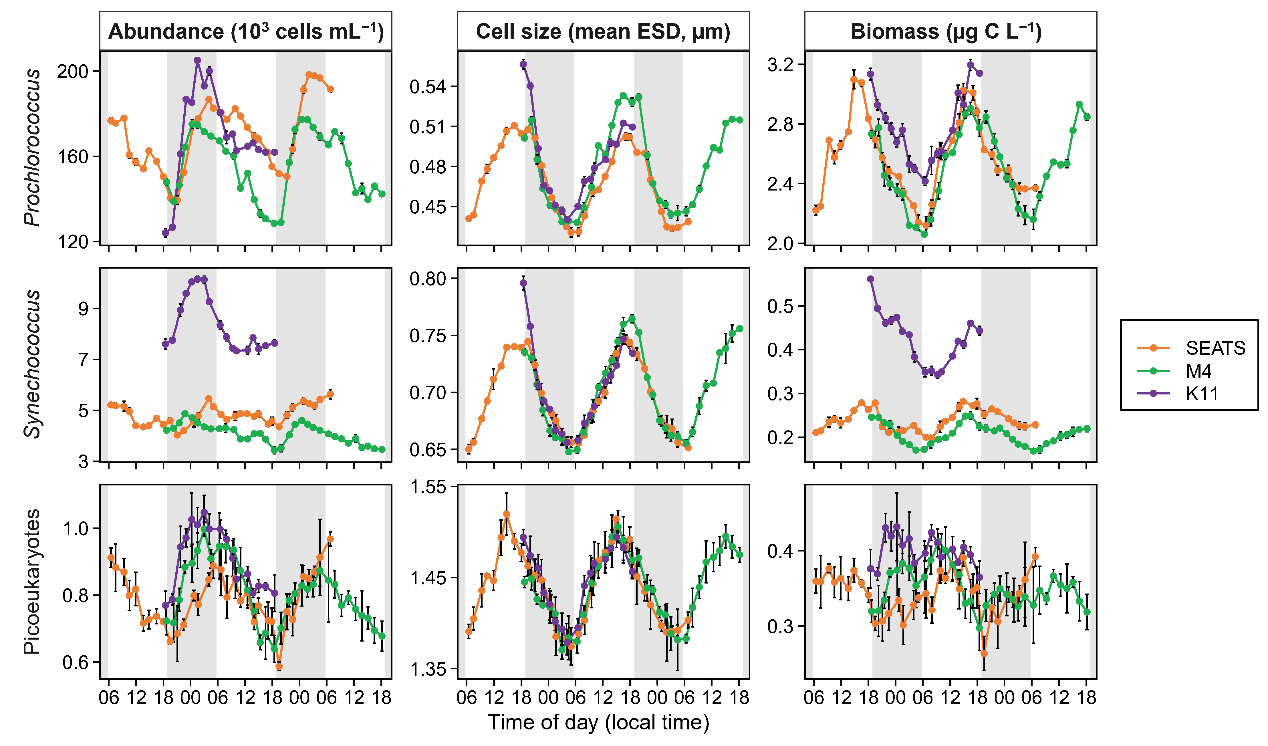A study by the team of Professor Bangqin Huang, published this spring in Geophysical Research Letters, confirms and extends previous results of diel patterns of autotrophic picoplankton in the oligotrophic ocean. The results reveal that the quasi-antiphase diel cycles in abundance and cell size/biomass of picophytoplankton are likely a general feature of near-steady-state oligotrophic ecosystems.
The oligotrophic ocean accounts for approximately half of Earth's surface and is the habitat of the greatest number of phototrophs in the world. In that nutrient-deficient environment, picophytoplankton (Prochlorococcus, Synechococcus, and picoeukaryotes) account for most of the photosynthetic biomass and primary production. Knowledge of the diel variability of these tiny microbes has important implications for the structure of microbial food webs and key biogeochemical processes.

Figure 1. Diel variation of picophytoplankton cell numbers, mean cell size, and biomass at three stations in surface waters of the northern South China Sea.
Time-series observations based on flow cytometry, a powerful technique that provides information about the numbers and sizes of picophytoplankton cells, have elucidated many ecological and biogeochemical processes associated with picophytoplankton, but some questions remain. A field survey in the northern South China Sea (Figure 1) combined with a published dataset (Figure 2) revealed that picophytoplankton cell size and biomass tended to decrease (increase) during the night (day) when cell numbers were increasing (decreasing). Such quasi-antiphase cycles are likely a general feature of near-steady-state oligotrophic ecosystems and reflect the cycles of carbon fixation, energy storage, and cell growth during the daytime and cell division and energy depletion during the night. Mortality rates estimated via modified dilution experiments showed that Prochlorococcus and Synechococcus were subject to considerable grazing pressure throughout the day and night. This work significantly improves our understanding of these microorganisms and may have implications for the carbon cycle in oligotrophic marine ecosystems.

Figure 2. Joint analysis of the SCS observations and SeaFlow dataset. (a) Average half-hourly values of picophytoplankton. (b) Circular boxplots showing the distribution of the peak times of the diel periodicity of picophytoplankton.
Changlin Li, Ph.D. candidate, is the first author, Prof. Bangqin Huang is the corresponding author; and Profs. Kuo-Ping Chiang and An-Yi Tsai from Taiwan Ocean University, Prof. Edward A. Laws from Louisiana State University, Prof. Xin Liu and Senior Engineer Jixin Chen from Xiamen University, Dr. Yibin Huang from University of California, Santa Cruz, Dr. Bingzhang Chen from University of Strathclyde are coauthors. This research was funded by the National Natural Science Foundation of China (no. 42130401, U1805241, 42122044, 41890803) and Southern Marine Science and Engineering Guangdong Laboratory (Guangzhou) (SMSEGL20SC02).
Source: Changlin Li, Kuo-Ping Chiang, Edward A. Laws, Xin Liu, Jixin Chen, Yibin Huang, Bingzhang Chen, An-Yi Tsai, Bangqin Huang*, Quasi-antiphase diel patterns of abundance and cell size/biomass of picophytoplankton in the oligotrophic ocean, Geophysical Research Letters, 49, e2022GL097753. https://doi.org/10.1029/2022GL097753
By Changlin LI | College of the Environment and Ecology, Xiamen University